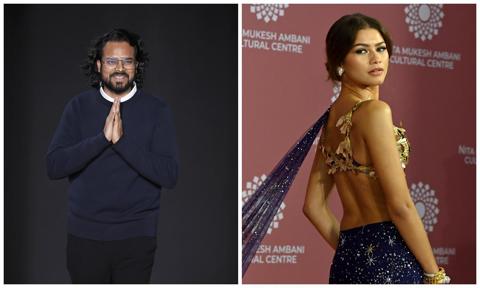
HELLO!: How does it feel to be labelled a ‘Game Changer in Fashion?’
Rahul Mishra: “It makes me feel incredibly happy and hopeful. I’m honoured that HELLO! has recognised our work and what we do globally as something ‘game changing’. I dream of a movement for Indian fashion, like the one that revolutionised Japanese fashion in the 1980s and 1990s by designers like Issey Miyake, Yohji Yamamoto and then Kenzo. I strongly believe that this decade is the beginning of India’s domination in fashion, and that by 2030, Indian aesthetics will be prominent across the globe.”
H!: You must be feeling at home right now in HELLO!’s ‘Enchanted Forest,’ given how so many of your designs are inspired by nature...
RM: “I really love the theme of the awards. In fact, one of our collections showcased at Paris Fashion Week during the pandemic was titled ‘Enchanted Forest’. An enchanted forest should be a way of life. We should always surround ourselves with what nature creates to stay inspired.”
H!: Among all your designs that celebrities have worn over the years, which ones stood out? We know you love what you created for Zendaya when she visited India recently...
RM: “For me, Zendaya was the perfect muse. I’m sure other designers across the world would agree. She’s courageous, she’s calm and is the ideal role model for the younger generation, which inspires our design process. I was glad to get complete freedom to create for her. I loved the looks that Shraddha Kapoor, Aditi Rao Hydari, Karisma Kapoor, and Malaika Arora sported at the opening of the Nita Mukesh Ambani Cultural Centre, how they carried themselves... But Zendaya stood out because this was her first time wearing a saree and I had never designed a pre-draped one before. All in all, it’s an absolute honour to see so many people wear the brand.”
H!: Do you think the industry today does enough to promote Indian artisans and textiles?
RM: “The conversation around handloom and its purity had begun when I was just starting out. But today, most collections, even at Lakmé Fashion Week, focus on craft and craftsmanship. So in a way, one could say there’s been change over the decades. Although I must emphasise that we, as designers, need to take care of all the artisans we work with, ensure that they have access to all the best possible facilities and fuel their dreams and aspirational lifestyle. Just recognition alone won’t bring them into the picture. They should also be compensated amply, and that’s the gap that I believe that’s yet to be filled. What proportion of the final selling price goes to the actual maker is important. We try to keep this to 30 percent of the MRP, but unfortunately, for handloom sarees, there are times even 5 percent doesn’t reach the weaver. So the system doesn’t just need improvement, it needs a complete overhaul, with support from the government, as well.”






